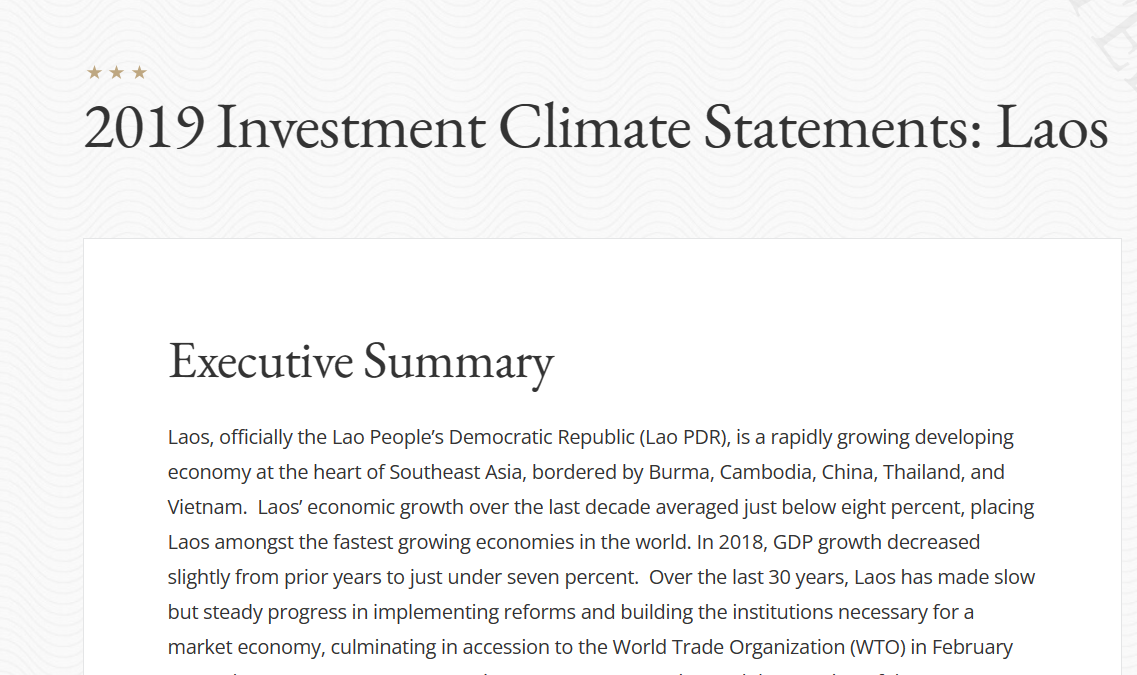Resource information
Laos, officially the Lao People’s Democratic Republic (Lao PDR), is a rapidly growing developing economy at the heart of Southeast Asia, bordered by Burma, Cambodia, China, Thailand, and Vietnam. Laos’ economic growth over the last decade averaged just below eight percent, placing Laos amongst the fastest growing economies in the world. In 2018, GDP growth decreased slightly from prior years to just under seven percent. Over the last 30 years, Laos has made slow but steady progress in implementing reforms and building the institutions necessary for a market economy, culminating in accession to the World Trade Organization (WTO) in February 2013. The Lao government’s commitment to WTO accession and the creation of the ASEAN Economic Community (AEC) in 2015 led to major reforms of economic policies and regulations aimed at improving the business and investment environment. The Lao government is increasingly tying its economic fortunes to the economic integration of ASEAN and export-led development.
The exploitation of natural resources and development of hydropower drove the rapid economic growth over the last decade, with both sectors largely led by foreign investors. However, the Lao government recognizes that growth opportunities in these industries are finite and employ few people, and has therefore recently began prioritizing the development of high-value agriculture, light manufacturing, and tourism, while continuing to develop energy resources and related electrical transmission capacity to export to neighboring countries.
The Lao government hopes to leverage its lengthy land borders with Burma, China, Thailand, and Vietnam to transform Laos from “land-locked” to “land-linked,” thereby further integrating the Lao economy with the larger economies of the countries along its borders. The government hopes to increase exports of agriculture, manufactured goods, and electricity to its more industrialized neighbors, and sees significant growth opportunities resulting from the China-Laos Railway, which will connect Kunming in Yunnan Province with Vientiane, Laos. The railway is expected to be completed and operational by 2021. Some businesses and international investors are beginning to use Laos as a low-cost export base to sell goods within the region and to the United States and Europe. The emergence of light manufacturing has begun to help Laos integrate into regional supply chains, and improving infrastructure should facilitate this process, making Laos a legitimate locale for regional manufacturers seeking to diversify from existing production bases in Thailand, Vietnam, and China. New Special Economic Zones (SEZs) in Vientiane and Savannakhet have attracted major manufacturers from Europe, North America, and Japan.
Economic progress and trade expansion in Laos remain hampered by a shortage of workers with technical skills, weak education and health care systems, and poor—although improving—transportation infrastructure. Institutions, especially in the justice sector, remain highly underdeveloped and regulatory capacity is low. Despite recent efforts and some improvements, corruption is rampant and is a major obstacle for foreign investors.
Corruption, policy and regulatory ambiguity, and the uneven application of law are disincentives to further foreign investment in the country. The Lao government, under the administration of the new Prime Minister Thongloun Sisoulith is making efforts to improve the business environment. Its current five-year plan directs the government to formulate “policies that would attract investments” and to “begin to implement public investment and investment promotion laws.” The Prime Minister’s publicly-stated goal is to see Laos improve its World Bank Ease of Doing Business ranking (Laos is currently ranked #154), and in February 2018, he issued a Prime Minister order laying out specific steps ministries were to take in order to improve the business environment. These efforts are having some impact – for example, it now takes to less than 40 days to obtain a business license, whereas just 4 years ago it took 174 days. The current administration is also more active in firing or disciplining corrupt officials, with the government and National Assembly disciplining over 1,000 officials in 2018 for corruption-related offenses. Despite these efforts, the Laos’ Ease of Doing Business ranking has fallen from 139 in 2016 to 154 in 2019. Furthermore, the multiple ministries, laws, and regulations affecting foreign investment into Laos create confusion, and thus, require many potential investors engage either local partners or law firms to navigate the confusing bureaucracy, or turn their efforts entirely toward other countries in the region.

